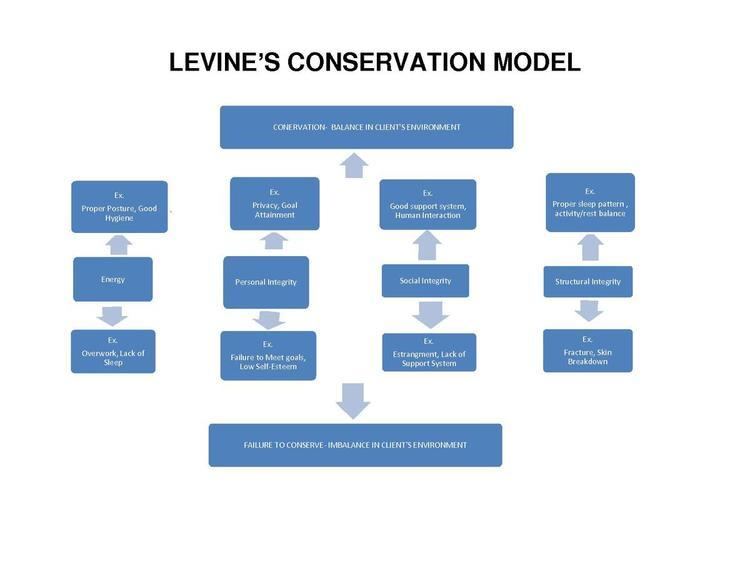 | ||
Myra Levine (a major influence in the nursing profession) set out to find a new and effective method for teaching nursing degree students major concepts and patient care. Levine's goal was to provide individualized and responsive patient care, that was less focused on medical procedures, and more on the individual patient's context. This led to the creation of a new nursing theory and approach to patient care.
Contents
- Key Concepts of the Conservation Model
- Nursing Process Using Levines Model
- Application of the Nursing Process in Levines Conservation Model
- Limitations
- References
The main focus of Levine’s Conservation Model is to promote the physical and emotional well being of a patient, by addressing the four areas of conservation she set out. By aiming to address the conservation of energy, structure, and personal and social integrity, Levine's model helps guide nurses in provision of care that will help support the client's health. Though conservation of physical and emotional well being is the most vital part of attaining a successful outcome for patients, two additional concepts, adaptation and wholeness, are also extremely important in a patient's health;
Key Concepts of the Conservation Model
The central concept of Levine’s theory is conservation. When a person is in a state of conservation, it means that individual has been able to effectively adapt to the health challenges, with the least amount of effort.
Myra Levine described the Four Conservation Principles. These principles focus on conserving an individual's wholeness:
Nursing Process Using Levine’s Model
1. Assessment- The collection of facts, by way of interviews and observation with the patient (considering conservation principles)
2. Judgement (Trophicognosis)- The application of nursing diagnoses which will provide the collected facts with meaning in the context of the patient’s circumstance
3. Hypotheses- The application of interventions that aim to maintain the patient’s wholeness and promote their adaptation in the current situation
4. Interventions- The use of interventions will test the nurse’s hypotheses
5. Evaluation- Assessment of the client’s responses to imposed interventions.
Application of the Nursing Process in Levine’s Conservation Model
Assessment- The nurse will observe and speak with the patient, in conjunction with medical reports, results and diagnostic studies to gather information- referred to as the collection of provocative facts.
Patients will be assessed for challenges to their external and internal environments that may impede their ability to achieve complete wellness and health. Areas focused on which may present such challenges are:
Judgement- Taking the provocative facts of the client’s situation and organizing them in a way that makes sense and adds meaning to the patient’s circumstances, in order to decide patient needs and possible nursing interventions. Using these judgments to decide about a patient’s needs is referred to as trophicognosis.
Hypotheses- Using his or her formed judgment, the nurse will speak with the client regarding these judgments with the client. Hypothesizing about the problem and its solution will eventually form a care plan for the patient.
Interventions- With the aim of promoting wholeness and adaptation, the nurse tests his/her hypothesis via direct care. These interventions aim to address the four areas of wellness (energy conservation, structural integrity, personal integrity and social integrity).
Evaluation- Evaluation of the interventions aimed at supporting the nurse's hypotheses seek to assess the client's response to the interventions. The evaluation considers both supportive outcomes (providing comfort to the client) and therapeutic outcomes (improving the client’s sense of wellness).
Limitations
Due to the fact that Myra’s Conventional Model primary focus is on the individual and their wholeness measured by one’s personal and emotional well being during a specific period of time, it has been contested that this model is not the best suited when it comes to addressing one’s illness in the long term. Thus, the conventions that Myra imposes on nursing students are more driven towards a patient’s satisfaction in their current state without looking to future conditions. In addition, satisfying only current conditions does not allow room for nurses to attempt to prevent illness if following this specific model as they are concentrated more on the individual than the illness.
